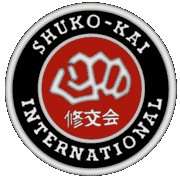Shūkōkai
|
Miyake Shūkōkai International logo | |
| Focus | Striking |
|---|---|
| Country of origin |
|
| Creator | Chōjirō Tani |
| Parenthood | Shitō-ryū • Gōjū-ryū |
Shūkōkai (修交会 shūkōkai) is a style of Karate, based on Tani-ha Shitō-ryū, a branch of Shitō-ryū developed by Chōjirō Tani in the late 1940s, and refined by his students, including Yamada Haruyoshi and Kimura Shigeru.
History
Chōjirō Tani (谷 長治郎 Tani Chōjirō) was born in 1921,[1] and started his formal karate training under Miyagi Chōjun, who founded the Gojū-ryū style, while a student at the Doshisha University in Kyoto. After a few months, Miyagi Chōjun returned to Okinawa and the founder of Shitō-ryū, Kenwa Mabuni took over the teaching. Upon graduating from university, Tani began learning Shuri-te and then Shitō-ryū from Mabuni as well. After many years of training under Mabuni and becoming one of his most senior students, Tani received the certificate of succession from him and became the head of Shitō-ryū, enabling him to use the name Tani-ha Shitoryu.
Chōjirō Tani began teaching the Karate style Shūkōkai (meaning the way for all)[2] at a dojo in Kobe, Japan in 1946. Shūkōkai was designed around the study of body mechanics, is very fast due to its relatively high stance aiding mobility,[3] and is known for the double hip twist, which maximises the force of its strikes; making it one of the most hard-hitting Karate styles.
Tani's most senior student, Sensei Shigeru Kimura, left Japan in 1965 to teach Shūkōkai in Africa. He developed Shukokai even further, emphasizing its power and strength; and was regarded as an expert on the style.[4] He continued to teach after travelling to Europe, before settling in the United States in 1970 at the age of 29, where he taught at Yonezuka's Cranford dojo for two years; creating the first Shukokai World Tournament in 1981. Sensei Kimura died of a heart attack at the age of 54. Tani died on 11 January 1998.[1]
Grading
The white belt (10th Kyu) is assigned to beginning students, who then progress to brown belt (1st Kyu), before reaching black belt (Dan). Certain Shukokai Karate associations do not have a red belt grade, making the white belt a ninth Kyu. In addition, certain associations also require a probationary black belt grade (Shodan-Ho) before progressing to fully fledged dan grading.
| Shūkōkai Karate Belt Order | |
| Black (Dan) | |
| Brown (3rd, 2nd and 1st Kyu) | |
| Purple (4th Kyu) | |
| Blue (5th Kyu) | |
| Green (6th Kyu) | |
| Orange (7th Kyu) | |
| Yellow (8th Kyu) | |
| White (9th Kyu) | |
Branches
Shūkōkai has evolved into several independent style branches throughout the world over the past few decades:
- Kimura Shukokai grew out of the Shūkōkai school taught since 1978 in Hackensack, New Jersey, United States and later in Tenafly, New Jersey by Shigeru Kimura, a long time student of Tani.[5][6] After Kimura's death in 1995, this international organization was formed to promote his style, co-led by his four senior students: Eddie Daniels, head of Shukokai Karate Federation, Bill Bressaw, head of American Shukokai Karate Union, Chris Thompson and Lionel Marinus of South Africa.
- Sankukai, founded in 1971 in Paris, France by Yoshinao Nanbu, a student of Chōjirō Tani. Yoshinao Nanbu abandoned the style to create Nanbudō in 1978, and Sankukai is currently taught by several national organizations throughout the world.
- Kawata-ha Seikukai Karate founded in Kawanishi, Hyōgo, Japan after the passing of Chōjirō Tani in 1998 by Kawata Shigemasa, his most senior student[7][8]
- Shito-ryu Shukokai World Union After the death of Tani sensei in 1998. Yamada Haruyoshi sensei was elected to lead the organisation of Shukokai. In 1956 he became a disciple of Tani sensei and was one of his top ranking pupils. He is one of the highest representatives of Japan Karate Federation and is also engaged in the Japanese Olympic Committee.[9]
References
- 1 2 "CHOJIRO TANI - TANI-HA SHITO-RYU (SHUKOKAI)". Shuriway. Retrieved 11 May 2010.
- ↑ Archived October 9, 2007, at the Wayback Machine.
- ↑ "SHUKOKAI-RYU KARATE-DO ASSOCIATION". Archived from the original on 2012-07-28. Retrieved 10 May 2010.
- ↑ "The History of K.S.K.A". KOBUSHI SHUKOKAI KARATE ASSOCIATION. Archived from the original on 1 September 2009. Retrieved 10 May 2010.
- ↑ Archived July 23, 2015, at the Wayback Machine.
- ↑ Archived December 8, 2006, at the Wayback Machine.
- ↑ Archived February 15, 2009, at the Wayback Machine.
- ↑ Archived April 10, 2013, at the Wayback Machine.
- ↑ "Shito-ryu Shukokai Karate Union World - 山田派糸東流修交会空手道世界連合". World governing body for Yamada-ha Shito-ryu Shukokai Karatedo.
